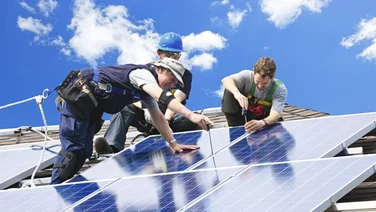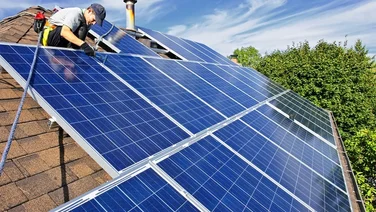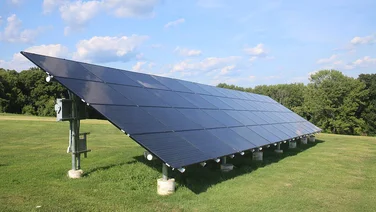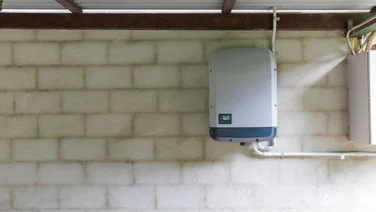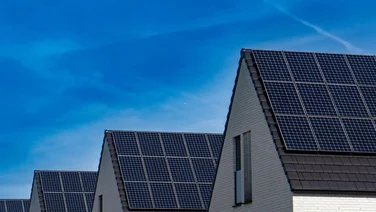✔ The first solar panel was created in 1883
✔ So far, over 1.4 million systems have been installed in the UK
✔ The cost of solar panels has shrunk by as much as 82% in the last decade
You might be familiar with the concept of solar panels, but how well do you really know them? With solar panel prices reducing over time, it’s no wonder a record number of people are making the switch.
Not only can they dramatically shrink homeowners’ carbon footprint, but they also provide the cheapest energy on the planet.
In fact, during the historic heat wave in August 2022, The Eco Experts found that UK-based searches for ‘solar panels’ hit their highest point ever, scoring 100 points on Google Trends – an increase of over 100% compared to the previous two months’ average score (49.5).
And with the solar industry evolving at a rapid rate, there’s a lot to catch up on. Luckily, we have everything you need to know about solar panels in the article below.
Where do you want to install solar panels?
Get started
Top 13 solar panel facts
1. Solar panels have been around for a long time
The concept of solar tech has actually been around since 1839. This is when French scientist Edmond Becquerel discovered the photovoltaic effect, at the ripe old age of 19.
Despite this incredible discovery, it wasn’t widely recognised until Einstein wrote a paper about the power of solar, which eventually landed him a Nobel prize in 1922.
But this was all theoretical. The first physical solar panel was invented by Charles Fritts in 1883, which only had an efficiency rating of about 1% – a long way off the 22% efficiency rates we see on the domestic market today.
2. They’re more popular than ever…
Fast forward to present day, and solar panels are popping up on roofs around the world.
As more of us become aware of our impact on the planet, more people are switching to renewable energy. And one of the easiest ways for homeowners to do this is by propping up a few solar panels on their roofs.
According to the MCS, over 1.4 million systems have been installed in the UK alone so far – with 1.09 million of those being domestic systems.
And this number is set to increase dramatically over the course of the next few years. In fact, the International Energy Agency (IEA) estimates that global solar capacity will quadruple by 2030.
The popularity of solar panels is growing among the general public. Our National Home Energy Survey found that 69% of Brits would buy a property that had solar panels installed, up from 65% last year.
As governments push for greener energy, many of them are offering more incentives to homeowners and businesses, encouraging them to switch to solar panels.
And with more countries adopting solar power, we can expect to see new innovations popping up soon – some farms have even started turning their fences into solar fences.
3. …which has caused their price to drop significantly
As demand for solar panels increases globally, prices are actually decreasing dramatically.
Overall, the cost of solar panels has shrunk by as much as 82% in the last decade. This mainly comes down to more manufacturers jumping on the solar bandwagon, which has created quite a competitive market. And as manufacturers fight for customers, prices continue to fall.
Today, the average solar panel system for a three-bedroom house in the UK costs just £7,026. Although this is still out of pocket for some households, it’s certainly become more achievable for others.
Where do you want to install solar panels?
Get started4. Solar panel efficiency has increased a lot
Despite solar panels getting cheaper, their performance is still going strong. The quality of solar panels is improving as the years go by – especially when it comes to their efficiency rating.
The efficiency rating of a solar panel measures the percentage of sunlight that hits a panel and is converted into usable electricity.
We analysed the most efficient solar panels on offer and found that Sunpower’s Maxeon 6 AC is the best option on the domestic market, with an efficiency rate of 22.8%.
But this panel is likely to be knocked off the top spot as experts continue to push boundaries on solar panel innovations. For example, a group of researchers broke the world record for solar cell efficiency in 2019, reaching an impressive rate of 47.1%. However, this was achieved by using multi-junction concentrator solar cells in lab conditions, and it isn’t commercially available yet.
5. The solar panel industry is evolving rapidly
There are currently three main types of residential solar panels available for homeowners: monocrystalline, polycrystalline, and thin film. But as the solar panel industry continues to evolve, different types of products are entering the solar market.
For example, if a homeowner wants to harness solar energy but doesn’t like the aesthetics of the panels themselves, they can now opt for solar tiles. These work exactly like solar panels (albeit, with a lower efficiency level), but are disguised as roof tiles.
Similarly, researchers have developed transparent solar panels to combat the issue of aesthetics. These products are essentially see-through solar panels, typically made of glass – although, most products only have a 30-40% transparency at the moment.
Researchers are also finding new innovative ways to harness even more energy with panels, such as:
- Bifacial solar panels – These cells can absorb sunlight on both sides so that incoming sunlight can be absorbed twice. Experts suggest these panels could produce between 10-20% more power than traditional panels
- Perovskite solar panels – These panels have two solar cells stacked one on top of the other and could work at 28% efficiency – around one-third more than current standard PV panels.
- Quantum dot solar panels – This new solar innovation uses ‘quantum dots’, which are tiny spheres of semiconductor material and have a ‘multiple exciton generation’ effect. This effectively squeezes out more energy from each photon in a light particle, and could increase efficiency rates to about 66%
6. They work in all sorts of climates
Contrary to popular belief, solar panels don’t need to be in direct sunlight to produce electricity – they work in all sorts of climates.
Don’t get us wrong, they’re certainly most efficient when they receive direct sunlight, but they still produce electricity when it’s cloudy or if part of the panel is in shade.
You’ll typically find that light cloud cover will lead to a power output loss of around 23.8%, while heavy cloud cover will reduce your output by 66.8%, according to the latest scientific research.
7. They’re very low maintenance
Solar panel systems have no moving parts, which means they’re pretty low-maintenance pieces of kit.
But if you want to reduce solar panel repair costs over time, you’ll need to take the following steps to look after them.
- Get the panels serviced annually
- Clean your solar panels about once a decade – although, this will probably need to be done more if the panels are in a particularly snowy, windy, or dusty environment
- Remove potential dangers, such as branches and other debris (thankfully, there are a few ways you can protect your solar panels from this)
- Keep solar panels out of the shade
- Make sure the inverters are flashing green
- Regularly check the day-to-day performance (you can usually do this on an app)
8. They have a tiny carbon footprint
Despite being the cleanest way to power the planet, wind, solar, and nuclear energy all have ‘hidden’ carbon footprints – meaning they might not always be as eco-friendly as they seem.
Although solar panels produce zero emissions whilst running, the way they’re produced can be quite harmful to the environment – but this heavily depends on where they’re manufactured. This is because a lot of countries still rely heavily on fossil fuels to power their factories, which is where solar panels are created.
This manufacturing process is why the carbon footprint of an average solar photovoltaic (PV) system is between 14-73 grams of carbon dioxide equivalent (CO2e) per kilowatt-hour (kWh).
Sounds like a lot, right? Well, it’s certainly not ideal, but it’s pretty harmless compared to the average emissions of burning oil – 742g of CO2e per kWh.
And if solar panel owners want to make their panels carbon neutral (meaning they balance out any CO2 they release into the atmosphere by removing the same amount), they only need to have their panels up and running for at least three years.
After this point, the solar panels’ overall carbon footprint drops into the negatives because they will have prevented more emissions from being released into the atmosphere than it took to create them.

9. We’re sending solar panels to space
Yes, you read that right – experts are planning to set up a solar farm in space.
There are multiple projects in the pipeline, but one of the companies at the forefront of this mission is LONGi Green Energy – the world’s largest solar company. This China-based company is planning to launch solar panels into space to test whether they can successfully work in orbit and transmit power back to Earth.
The LONGi Green Energy Future Energy Space Laboratory has claimed that it aims to “promote the integrated development of aerospace technology and new energy”.
But China isn’t the only one thinking of going sci-fi on solar. The European Space Agency (ESA) has also unveiled a plan to send solar panels to space. Although the project is still in the preliminary testing phase, organisers have suggested the end goal is a solar space farm that would stretch for 2 kilometres (km), and would orbit 36,000 km above the Earth.
10. Solar panels produce the cheapest energy on the planet
Solar energy is officially the cheapest energy source in the world (closely followed by wind power) after it became more affordable than gas in 2021.
This is a significant improvement compared to the cost of solar energy a decade ago – and it’s only getting cheaper. The price of solar power generation fell by 88% between 2010 and 2021, and by 13% in 2021 alone.
Renewables are predicted to continue this trend of getting cheaper, whilst fossil fuel prices surge across the globe – a trend that has been accentuated by Russia’s invasion of Ukraine.
11. They can work in harmony with agriculture
Former UK Prime Minister Liz Truss did a lot of damage in her 44 days in charge, including dragging the solar name through the mud. The Conservative PM claimed that “our fields should be filled with our fantastic produce – whether it’s the great livestock, the great arable farms” rather than solar panels.
But we don’t have to choose between solar farms and agricultural land – the two can work together in harmony.
Farmers can grow an array of fruits and vegetables, maintain grain fields, and home livestock – all on the same land as a solar farm.
Around the globe, agricultural workers have started propping up panels onto stilts to create this dual-function farm. Not only does this mean the solar panels can bask in the sunshine and absorb energy, but they can also provide shelter for animals, fruits and vegetables, and precious ecosystems during particularly hot or rainy days.
12. Solar panels could power the planet…
We can’t rely on fossil fuels forever – after all, there’s only a limited amount of gas and oil left. And as fossil fuel supplies run dry over the course of the next few decades, prices will surge even higher.
Luckily, we can power the world with renewable energy – with solar panels leading the way.
Making this happen would require a lot of new infrastructure, and we need to make sure this doesn’t have a negative impact on local ecosystems.
Thankfully, powering the world with renewables might not take up as much space as you’d think. According to Forbes, solar panels covering a surface of around 335 km² would actually be enough to power the world – this would cover just 1.2% of the Sahara Desert.
13. …but we’d need to have much more storage capability
Powering the world with solar energy can only be a reality if we have sufficient energy storage capacity.
Renewables are clean and cheap, but one of their downsides is that their supply can be inconsistent. The sun isn’t always shining, wind levels fluctuate during different seasons, and waterways can prove unreliable during droughts.
But if we’re able to store any excess energy during peak periods, the instability won’t matter.
However, as it stands, only 3% of power capacity is being stored globally. To limit global warming to below 2°C, energy storage capacity needs to triple by 2050.
Summary
The global energy industry is gradually transitioning from dirty fossil fuels to clean renewables – and solar panels are at the forefront of this movement.
As solar panels continue to improve in efficiency rating whilst also getting cheaper, more homeowners and businesses are predicted to make the swap to cleaner energy.
And with the solar industry evolving at such a rapid rate, who knows what sort of innovations are in store for us in the next few decades?


